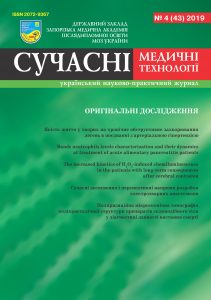Traumatic disease peculiarities course, its diagnostics and treatment at polytrauma in suffer obese patients
DOI:
https://doi.org/10.34287/MMT.4(43).2019.9Abstract
Introduction. It’s known that the issue of polytrauma is one of the most urgent problems of surgery, and among injured patients a special approach is required for patients with overweight and obesity of varying degrees.
Purpose of the study. To study prognostic features of traumatic disease course and to improve the results of diagnostics and surgical treatment of patients with polytrauma suffer obesity.
Materials and methods. Clinical material was made up of 106 patients with combined body trauma, which were divided into three groups according to body mass index.
Results. The results of the research showed a significant difference in the course of traumatic disease in patients with normal body weight and obesity. In particular, in the process of diagnostics of blunt chest and abdominal trauma the frequency of application of interventional methods of diagnostics was directly proportional to the increase of body mass index. The course of traumatic disease in the obese patients had a number of characteristic features that formed the basis for the development of diagnostics and differential program of treatment.
Conclusions. The results of the research showed that the course of traumatic disease in combined injury obese patients is directly proportional to the body mass index and has certain features that differentiate them from patients with normal body weight.
References
Neville A, Brown CVR, Weng J, Demetriades D, Velmahos G. Obesity is an independent risk factor for mortality in severely injured blunt trauma patients. Arch Surg. 2004; 139: 983–987. DOI: 10.1001/archsurg.139.9.983.
Brown CVR, Neville A, Rhee P, Sangthong B. Obesity and Traumatic Brain Injury. The Journal of trauma. 2006; 61 (3): 572–576. DOI: 10.1097/01. ta.0000200842.19740.38.
Brown СVR, Velmahos GС. The consequences of obesity on trauma, emergency surgery, and surgical critical care. World J Emerg Surg. 2006; 1: 27. DOI: 10.1186/1749-7922-1-27.
Hayko HV, Derkach RV. Analysis of causes and factors that cause mortality of victims of musculoskeletal injuries sustained during an traffic accident. Nauka i praktyka: mizhvidomchyy medychnyy zhurnal. 2014; 1: 82–86.
Hetman VH, Makarov AV, Linchevskyy OV, Myasnikov DV. Polytrauma Surgery: Ways to Improve. Torakalnakhirurhiya: zbirnyknaukovykh prats. Vypusk 1, chastyna 1. Kirovohrad, 2010; 27–28.
Bokhari F, Fu CY, Bajani F. Morbid Obesity Is Protective in Blunt abdominal trauma. J Am College of Surgeons. 2018; 227 (4 Suppl. 2): e 63. DOI: 10.1016/j.jamcollsurg.2018.08.176.
Gray S, Dieudonne B. Optimizing Care for Trauma Patients with Obesity. Cureus. 2018; 10 (7): e3021. DOI: 10.7759/cureus.3021.
Haines KL, Clayton J, Agarwal R. Effects of Obesity on Penetrating Trauma. J Am College of Surgeons. 2018; 227 (4 Suppl. 2): e 62. DOI: 10.1016/j.jamcollsurg.2018.08.174.
Licht H, Murray M, Vassaur J, Jupiter DC. The Relationship of Obesity to Increasing Health-Care Burden in the Setting of Orthopaedic Polytrauma. J Bone Joint Surg Am. 2015; 97 (22); е73. DOI: 10.2106/JBJS.O.00046.
Chen AK, Jeffcoach D, Stivers JC et all. The impact of obesity on severity of solid organ injury in the adult population at a Level I trauma center. Trauma Surgery and Acute Open Care. 2019; 4 (1): e000318. DOI: 10.1136/tsaco-2019-000318.
Weinlein J.C., Deaderick S., Murphy R. Morbid Obesity Increases the Risk for Systemic Complications in Patients With Femoral Shaft Fractures. J. Orthopaedic Trauma. 2015; 29 (3): е91-95. DOI: 10.1097/BOT.0000000000000167.
Downloads
Published
How to Cite
Issue
Section
License
The work is provided under the terms of the Public Offer and of Creative Commons Attribution-NonCommercial 4.0 International (CC BY-NC 4.0). This license allows an unlimited number of persons to reproduce and share the Licensed Material in all media and formats. Any use of the Licensed Material shall contain an identification of its Creator(s) and must be for non-commercial purposes only.














